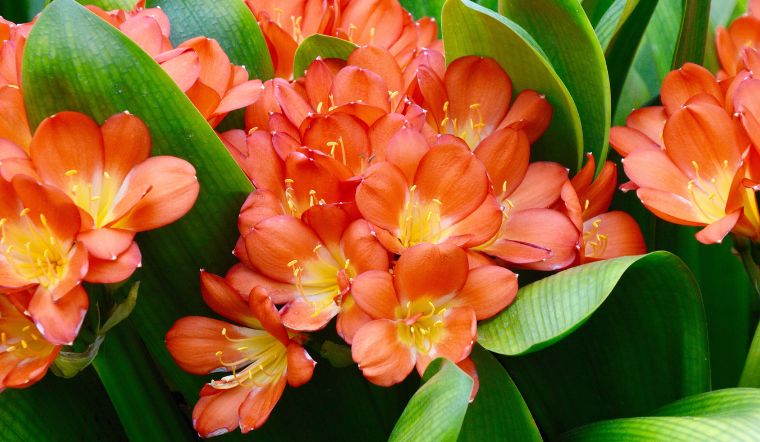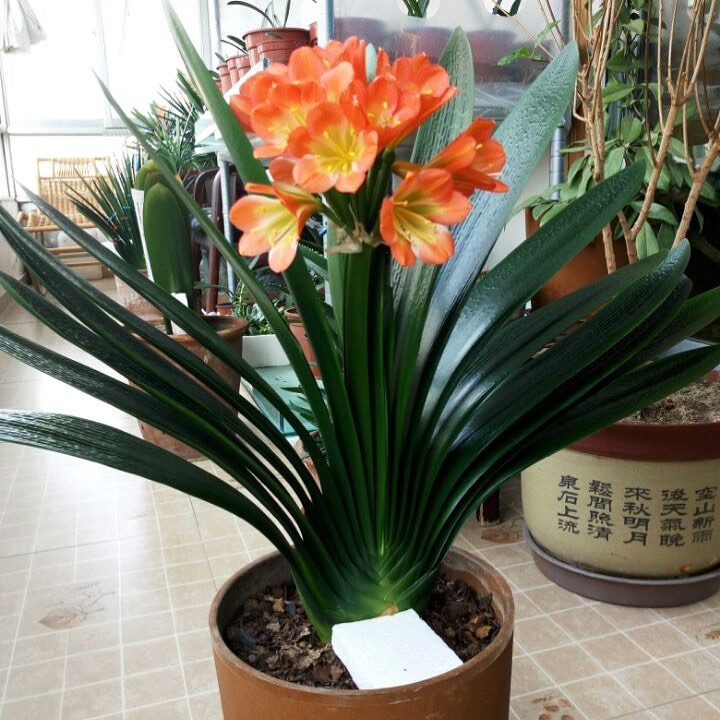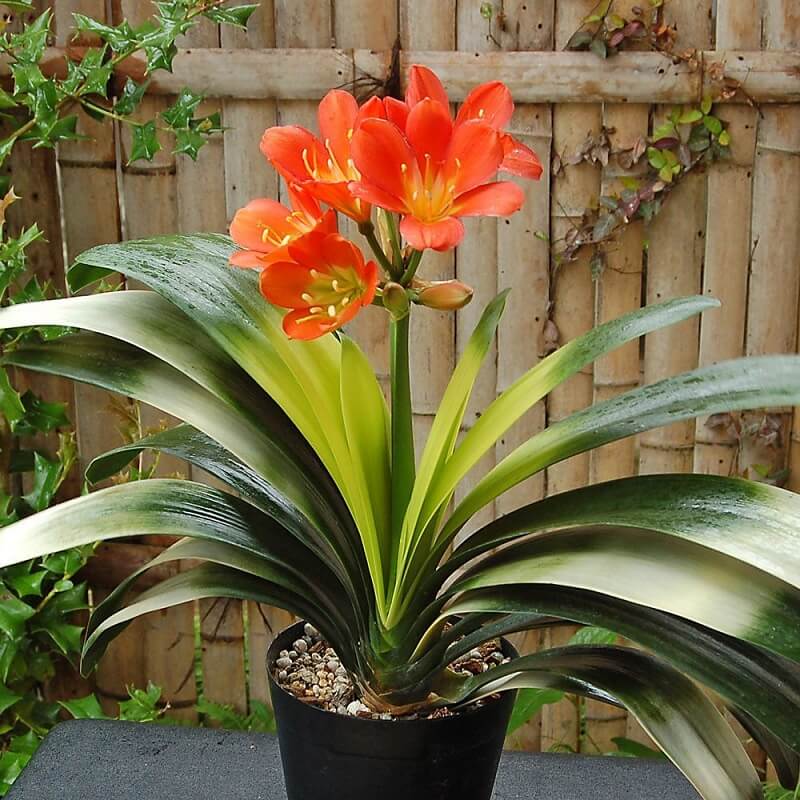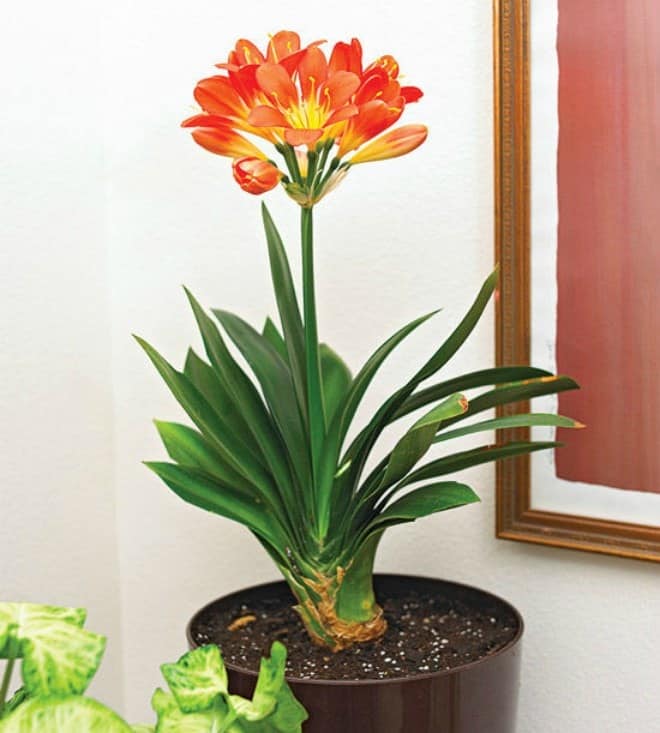The Clivia nobilis, commonly known as the Noble Clivia or Red Spider Lily, is a stunning plant native to South Africa. This herbaceous perennial can grow to heights ranging from 30 cm to 1 meter. Its deep green, glossy leaves are arranged in a striking layered pattern, ensuring the plant remains aesthetically pleasing even when not in bloom.
The flowers of the Noble Clivia are a vibrant spectacle, boasting hues of yellow, red, and orange. These blooms last for about a month before gracefully fading. The plant’s fruits are small, bright red berries that take a year to ripen. Beyond its beauty, the Noble Clivia is prized for its resilience and adaptability to various growing conditions.
In the practice of Feng Shui, the Noble Clivia represents strength and resilience, symbolizing the ability to overcome challenges. The lush, long-lasting blooms signify prosperity, good fortune, and abundance.

The Noble Clivia is seen as a symbol of strength and resilience in Feng Shui
Notably, the Noble Clivia often blooms around the Lunar New Year, making it a popular choice for festive decorations. It is believed to bring wealth and good fortune for the coming year, serving as a harbinger of peace and a dispeller of bad luck from the previous year.
With its vibrant shades of red, orange, and yellow, the Noble Clivia is an ideal choice for those with Earth and Fire elemental signs in Feng Shui. Displaying this plant in your home is said to promote harmony, luck, and abundance in all aspects of life.
Beyond its symbolic significance, the Noble Clivia is also valued for its ability to absorb electronic radiation and purify the air, creating a healthier and more comfortable living environment.
Propagation of the Noble Clivia can be achieved through two main methods: seed germination or root division. However, it’s important to note that this plant has a slow growth rate. Seed germination can take up to six years before the plant produces flowers. On the other hand, root division, when done properly, can result in root formation within a month, and flowers can be expected after two years. Alternatively, you can purchase young plants from nurseries to bypass the waiting period.

Propagation can be achieved through seed germination or root division
To ensure annual blooming, consider the following essential care tips:
Choose the Right Planting Container
Proper root care is crucial for the Noble Clivia’s vigorous growth, and this starts with selecting the right container. Clay pots, especially red clay, are ideal due to their breathability and excellent drainage. These pots help maintain optimal moisture levels while preventing waterlogging, which is essential for protecting the roots from rot.
If you prefer not to use clay pots, you can opt for other types of containers, ensuring they have drainage holes at the bottom. The container size should be proportionate to the plant’s size, generally allowing enough space for the root system to spread out. Avoid using overly large pots, as they can retain water for extended periods after watering, potentially harming the roots.
Use High-Quality Potting Mix
The roots of the Noble Clivia are sensitive and require careful attention. To prevent root dryness or waterlogging, the potting mix should be airy and well-draining. A recommended mix for Noble Clivia is a blend of garden soil, peat moss, organic fertilizer (such as manure), and river sand or pearl stones in a 6:2:1:1 ratio.
Before use, it’s best to sun-dry the prepared mix to sterilize it, and you can also add a small amount of carbendazim to enhance sterilization. Additionally, if your plant is in a container, consider repotting it with fresh soil every two years, preferably in spring or autumn, to promote better growth.

Consider repotting your Noble Clivia every two years
Provide Adequate Light and Shade
The Noble Clivia’s leaves are thick, water-rich, and coated with a thin membrane, making them sensitive to intense sunlight. Therefore, it’s best to place the plant in an area with scattered light and no direct sunlight. Ensure your plant receives at least four hours of light daily; otherwise, flowering may be affected.
As autumn arrives and temperatures cool down, you can gradually increase the amount of light your plant receives. This additional light exposure will stimulate flowering. Remember to maintain a well-ventilated environment for your Noble Clivia to thrive.
Water Your Noble Clivia Carefully
The Noble Clivia is sensitive to waterlogging, so watering must be done carefully to avoid root rot. One popular method is to slowly pour water in a circular motion around the base of the plant, providing just enough water to ensure the plant receives the necessary moisture.
Alternatively, you can soak the plant’s container in a larger basin of water, ensuring the water level doesn’t exceed the rim of the pot. After 3-5 minutes, the soil will absorb enough water, creating optimal conditions for the Noble Clivia’s growth.

The Noble Clivia is sensitive to waterlogging, so water carefully to avoid root rot
Fertilize Your Noble Clivia Correctly
Proper fertilization is key to ensuring the Noble Clivia’s robust growth. A balanced fertilizer provides essential nutrients to promote the plant’s overall health.
Specifically, during the first half of the year, when new leaves emerge, apply a mixture of nitrogen, phosphorus, and potassium twice a month. This will help develop thicker, darker green leaves. If the ambient temperature falls below 25°C, reduce the frequency to once a month. If the temperature exceeds 25°C, discontinue fertilization.
In the autumn, as the Noble Clivia enters its peak growth period, focus on phosphorus and potassium fertilization (such as potassium dihydrogen phosphate or Huaduoduo No. 2) to support flower bud formation. During this phase, dilute the fertilizer and apply it once or twice a month.
Additionally, before the flowering phase, expose the plant to cooler temperatures of 5-10°C for about ten days. This treatment encourages shorter, stronger, and broader leaves, facilitating flower bud formation. Subsequently, to stimulate blooming, create a temperature differential of about 10°C between day and night, prompting the Noble Clivia to burst into a vibrant display of blooms.






































